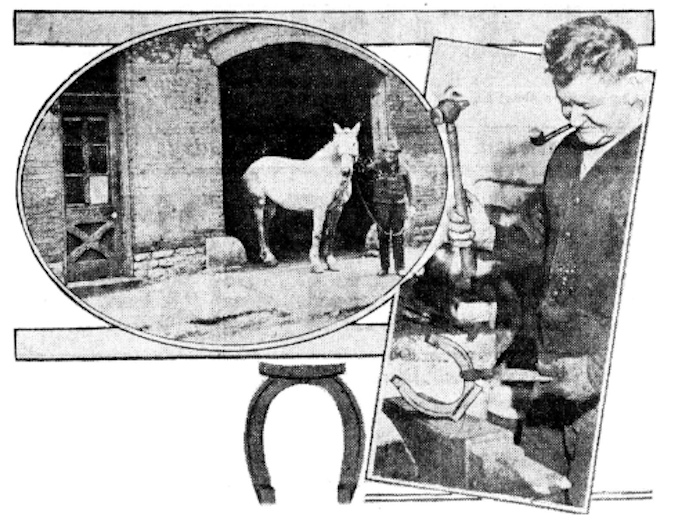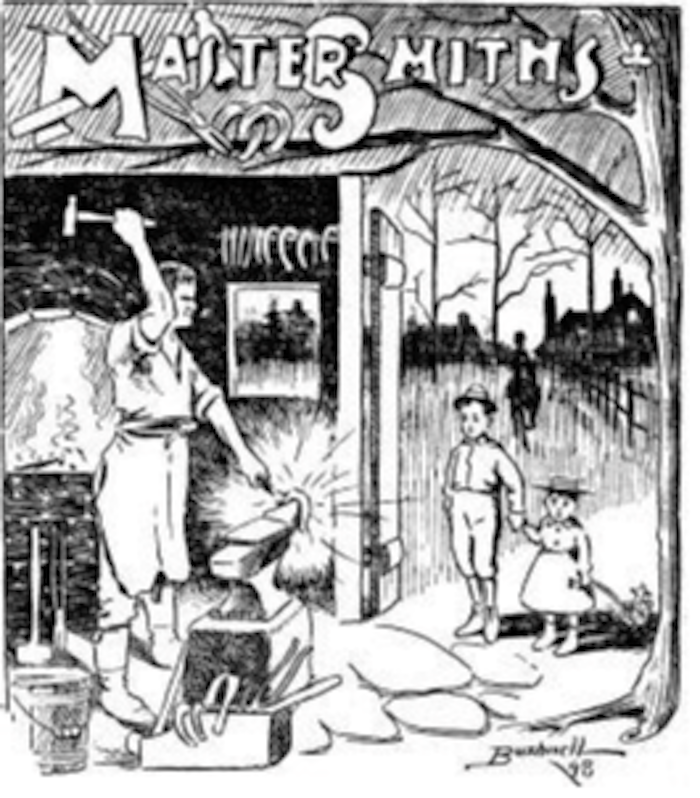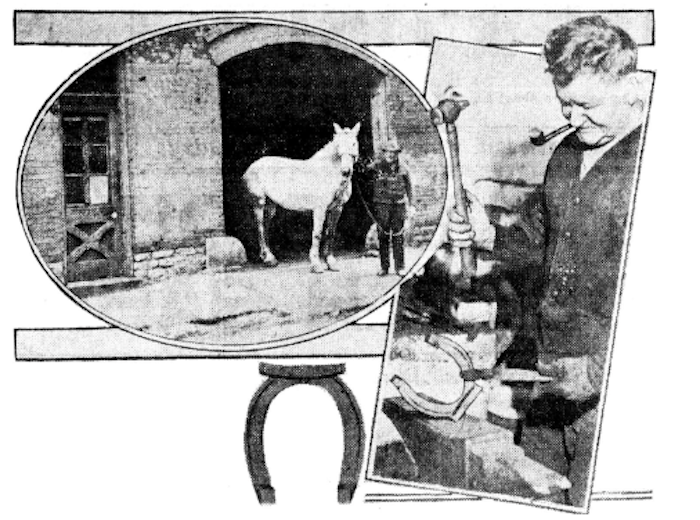With all the talk these days about artificial intelligence and its anticipated devastation of employment as we know it, let’s peer into some balmier times and the technological disruptions inflicted on past trades—specifically, horseshoeing.
Up until about World War I, unless you traveled by railroad or electric streetcar, you needed a horse to get around, and horses needed regular shoeing. Especially in urban environments with cobblestone or crushed gravel pavement, horses might need new shoes every 10 days or so.
Two Horseshoeing Unions
Horseshoeing was a lucrative trade, and it was unionized. In fact, there were two horseshoeing unions, one for the journeymen and one for their bosses.
“When the horseshoers’ union disbanded in 1946, there were only 10 members…”
The Master Horseshoers’ Protective Association met in Cincinnati for a national convention in 1898. They were very concerned about a new mode of transportation that threatened their livelihoods — the bicycle. It is impossible to exaggerate the bicycle’s explosion in popularity during those. Two years later, the horseshoers were still feeling the pinch and hoping bicycles were nothing but a passing trend. The Cincinnati Post (October 18, 1898) reported the view of one convention delegate:
“H.E. Richards, representing the Ausable Horse-Nail Company of New York, gives it as his opinion that the bicycle is only a fad, that is dying out. He declares that in the midst of the craze the business of his company fell off. Now, he says, it is picking up. The wheel, he says, is passing, and the horse is the thing again.”
Autos, Bikes Just a Fad
Richards was not alone in his over-optimistic prognostications. As late as 1920, when automobiles had all but monopolized the city’s streets, the Cincinnati Enquirer (April 6, 1920) saw hope for the horse:
“The horse is coming back in a last struggle to hold his place against the progress of the automobile, tractor, truck and airplane. The Department of Agriculture estimates that horses on U.S. farms increased from 19,833,000 in 1910 to 21,109,000 on January 1, 1920. Mules increased, too, according to the estimates.”

J.D. Antill, with the horse, and Henry Imholt, with the horseshoe, were among the few Cincinnati men earning a living from horses in 1932. Image extracted from microfilm by Greg Hand
That year, the Journeyman Horseshoes held their national conference in Cincinnati and desperation seethed through the delegates. According to one, quoted in the Cincinnati Post (July 19, 1920) automobilists and their ilk were antagonizing The Almighty himself:
“Bernard Flatley, president, said horseshoers had made little progress until the war showed them their importance in industry. He urged more publicity for the horse. ‘Man is flying in the face of God,’ he said. ‘The horse is a creation of God and should not be relegated to the side of the road to make place for the inventions of man.’”
Looking at old photographs and rare antique films today, a person might be forgiven for thinking the automobile had completely obliterated the horse by the early 1920s. Not so.
At the beginning of the Great Depression, the Cincinnati Post (April 5, 1932) profiled two Cincinnati businesses still dependent on horseshoes.
Cincinnati Called Home
For 21 years, Cincinnati has been home for the mid-winter International Hoof-Care Summit that attracts as many as 1,000 attendees from the U.S. and as many as 20 foreign countries.
Due to extensive construction work at Cincinnati’s convention center, the 22nd annual International Hoof-Care Summit will be held in Kansas City. Mark the dates of January 21-24, 2025, on our calendar and join the American Farriers Journal staff for this event at the Sheraton Kansas City Hotel at Crown Center.
J.D. Antill ran a livery at 1118 Clay Street in Over-the-Rhine. His stable boarded 12 horses at that time, but many of his stalls were vacant and cobwebbed. Most of his customers were peddlers. Although Antill recalled bygone days when every Sunday was busy with young men renting buggies to take their ladies for country drives, his lone remaining rig sat dusty and unused.
Henry Imholt pounded out iron horseshoes at 1108 Broadway in Pendleton. When there weren’t enough horses to shoe, the Imholt smithy got by forging ice tongs — just as electric refrigerators were beginning to spell the end of the iceman’s visits.
160 vs. Fewer Than 25 Union Members
In 1932, Cincinnati membership in the Journeyman Horseshoers dropped to fewer than two dozen from a peak of more than 160 card-carrying members in decades previous. The Master Horseshoers’ Protective Association had long since disbanded.
Still, diehards insisted automobiles were on the way out. Charles Selzer was chief horseshoer at the French Bauer dairy. He told the Cincinnati Post (April 3, 1929) that the day of reckoning approached when mankind would abandon the frivolous automobile:
“’It will come a time,’ he explains ‘when big business will not have so much money. They will have to save. Autos and trucks cost money. So big business will go back to drays which don’t cost so much. Then it will happen, also, that the workingman will get smaller pay, and he will be glad to own a horse and rig instead of an auto. He will like it, too — you will see. There is no sport in driving a car.’”

The media welcomed the Master Horseshoers’ Protective Association as one of the largest conventions held in Cincinnati in 1898. Almost 30 years later, the organization disbanded. Image extracted from microfilm by Greg Hand.
In 1929, all the milkmen employed by French Bauer delivered their dairy products by horse-drawn cart. Charles Selzer managed the in-house smithy for the firm at Seventh and Smith streets out in the West End.
Alas, Selzer never lived to see the automobile get its comeuppance. In fact, quite the opposite occurred. In 1956, the Cincinnati Post returned to French Bauer to talk with the last remaining horseshoer on the payroll.
Henry Luehrmann was 64 years old and no longer shoed horses. French Bauer had abandoned horse-drawn carts in 1946 and Luehrmann was transferred to the refrigeration department. Even though he hadn’t shod a horse in a decade, Luehrmann remained secretary of Local 12 of the Horseshoers’ Union, a group that had not met in a decade and existed only as a listing in Cincinnati’s AFL Union Directory.
When the horseshoers’ union disbanded in 1946, there were only 10 members. In 1956, Luehrmann could think of only two remaining card-carriers, John McGinnis in Maderia, Ohio, and N.C. Jackson in Highland Heights, Ky., who both still shod horses. Luehrmann had long since transferred to the Milk and Ice Cream Drivers and Dairy Employees Union, which generously allowed him to keep his seniority.
“Cabinets are easier to work with than horses,” he told the Post. “They don’t kick. But horses are more interesting. As a trade, horseshoeing was one of the best. Most of us worked steady and the pay was good.”
Back in 1898, the Master Horseshoers took the trolley out to Chester Park and posed for pictures on the steps of St. Peter Cathedral. They also argued about whether their standard fees for shoeing city horses were just good business practice or a monopolistic restraint of trade. Times were good, even though the handwriting was on the wall.
Published with permission from Cincinnati Magazine.








Post a comment
Report Abusive Comment